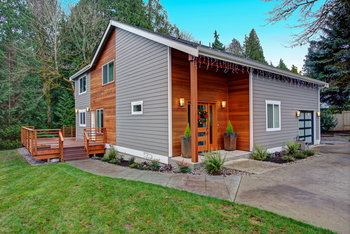Alex Castellanos, president of the Mortgage Bankers Association of Florida, says many of his clients think that they need a 20 percent down payment to qualify for a conventional mortgage loan today. Not so.
Borrowers with good credit, low debt and strong monthly incomes can qualify today for conventional mortgage loans with down payments of as little as 3 percent, Castellanos says.
"People need to know this," he says. "They need to know that down payments are no longer the hurdle they were immediately after the housing crash."
In Downpayment Expectations & Hurdles to Homeownership, a survey conducted by the National Association of Realtors in 2020, it was noted that "Consumers typically believed that they would need a median of a 20 percent downpayment to purchase a home today. Thirty-five percent of consumers indicated that believed they would need between 16 to 20 percent for a downpayment, and 21 percent believed that they would need between six to 10 percent for a downpayment today."
With median home prices sharply rising over the last couple of years, it's a good thing that a 20% down payment isn't actually required.
Today's low mortgage rates help you qualify for a larger loan amount, but coming up with 20 percent of the home's purchase price is a struggle for many. A 20 percent down payment on a $300,000 loan is $60,000. A 5 percent down payment is just $15,000, and even 3 percent down equals $9,000.
You don't need 20 percent down
Richard Simon, owner of AZ Lending Experts in Mesa, Ariz., says that both credit score and debt guidelines are looser than they used to be for borrowers making a smaller down payment.
Traditionally, Fannie Mae and Freddie Mac have both stated in their guidelines that your total monthly debts should equal no more than 36 percent of your gross monthly income.
But Simon says that it's possible for borrowers to get approval today for conventional loans with down payments of 5 percent, even if their total monthly debts equal as much as 50 percent of their gross monthly income.
Borrowers will need to show enough reserve income in their bank accounts to pay three months worth of mortgage payments to qualify at that ratio of 50 percent, Simon says. Those without such reserves can qualify with monthly debts as high as 45 percent, he notes. However, the borrower's credit score will need to be above 720.
Related: Down Payment Decisioner Calculator
Down payment requirements
What do you need to qualify for a loan with a low-down-payment? There are some general guidelines, though these can vary by lender:
10 percent down payment
For a loan with 10 percent down, Simon says you need a FICO credit score of at least 680 for a conventional mortgage. That's an improvement from a few years ago, when you would have needed a FICO score of at least 740, he says. You'll need a back-end debt-to-income (DTI) ratio (that compares your total monthly debts to your gross monthly income) of 36 percent, he says. A FICO 720 would be required if your DTI is above 36%.
5 percent down payment
Simon says you'll need a FICO score of 680 or higher and a back-end DTI ratio that doesn't exceed 36 percent (or 720 if your DTI is above 36% but below 45%).
3.5 percent down payment
Your best bet for a mortgage loan with 3.5 percent down is one insured by the Federal Housing Administration (FHA). Jerry Calnin, branch manager of Inlanta Mortgage in De Pere, Wis., says that many lenders won't approve FHA loans for borrowers with credit scores under 620, despite the official FHA guideline of 580. If your FICO score is at least 640 you'll have much better luck getting approved, he says.
3 percent down payment
For a conventional 3% down loan, you'll need a FICO score of 680 or higher, and a back-end DTI ratio closer to the traditional 36 percent, Simon says. Fannie mae and Freddie Mac also offer 3% programs aimed at first-time homebuyers (called HomeReady and HomePossible) that have some restrictions but can offer reduced fees and mortgage insurance costs.
These programs from Fannie Mae and Freddie Mac can compare favorably to FHA-Backed loans. HSH offers a unique calculator and low down-payment mortgage comparison tool so you can do side-by-side comparisons for these loans and see which will be less costly to you over time.
Related: FHA Mortgage Calculator and Low Downpayment Mortgage Comparator
0 percent down payment
For conventional mortgage loans, 100 percent financing is still a rarity, but credit unions and lenders might offer them as part of their portfolio collections -- loans that lenders keep in-house rather than sell on the secondary market. You'll need an excellent credit score and low DTI ratio to find a lender willing to offer 100 percent financing. Depending on where you live, the USDA may back a mortgage with no money down.
Many state-backed homebuying programs aimed at low- and moderate-income homebuyers have no downpayment requirements, or offer forgivable loans or outright grants to cover the downpayment and closing costs. Eligibility varies by locale, but these can be worth checking into if you are struggling to come up with a down payment.
If you're a veteran or active duty member of the U.S. Military, you might qualify for a loan insured by the U.S. Department of Veterans Affairs. VA loans require no down payment. Loans insured by the U.S. Department of Agriculture (USDA) also require no down payment, though you must live in a designated area to qualify. Calnin says you'll need a back-end DTI ratio of about 41 percent to qualify for a USDA loan or a VA loan.
A conventional mortgage with less than 20 percent down will require private mortgage insurance which is added to your monthly mortgage bill.
Calnin says that he likes the lower down payment requirements since they make it easier for borrowers to get into homes, and there is no evidence that higher down payments equal fewer mortgage defaults.
"Loans with lower down payments are not riskier," he says. "Not only are these loans out there, they're also safe."
This article was revised by Keith Gumbinger



